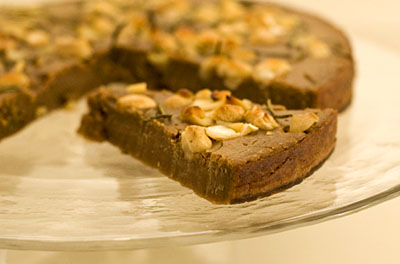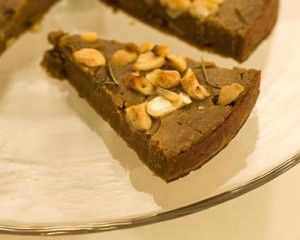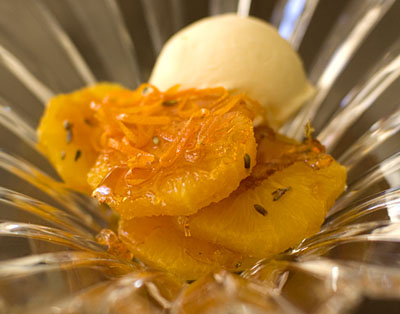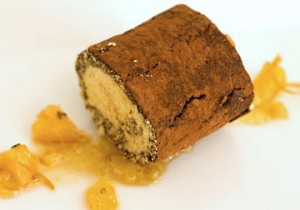Castagnaccio
Plainsboro Lunch Lady: [serving sloppy joe sandwiches at school lunchtime] They’re not really bad if you’ve never had really good ones.
–Rocket Science, 2007.
Remember Little Miss Sunshine? I watched it, not knowing too much about it, and was completely charmed by the movie and delighted by how unexpectedly good it was. I recently watched Rocket Science and had a similar feeling of happy discovery. Rocket Science is a bittersweet and very human comedy, and was made by Jeffrey Blitz, who also brought us Spellbound, that completely engrossing documentary about the 1999 National Spelling Bee held in Washington DC.
Happy discovery, is also my reaction to this Castagnaccio, a flat Italian chestnut flour cake which is a speciality of an Italian province, Lucchesia.
The first time I tried this cake was when Jaci and I attempted to bake one at work, several years ago. Never having tasted Castagnaccio before and not knowing what to expect, we found it really odd tasting, to the point of being unpalatable, and ended up throwing most of it in the bin (heart-breaking, when you know how much chestnut flour costs). We even considered writing to the cookbook author (it was either Stephanie Alexander or Maggie Beer; I can’t remember which) to query the logic behind the inclusion of the recipe in the book! In hindsight, I think our cake did not turn out well because the chestnut flour had soured. I didn’t know this then, but chestnut flour doesn’t keep very well. It should ideally be stored in the freezer and used within 6 months.
This time round, emboldened by a reliable cookbook by Anna del Conte and a bag of chestnut flour that would go to waste if I did not utilise it soon, I decided to reattempt the Castagnaccio. With great relief, the cake emerged triumphantly from the oven, brown like a roasted chestnut, and fragrant with rosemary. A wedge of this cake, eaten warm, not long after had been out of the oven, was very soothing, and the combination of rosemary and chestnut worked a treat. Having said that, I can imagine this cake would have it’s share of detractors as well. It has a pasty pudding-like texture that reminds me of some asian desserts/cakes I grew up eating. While I’m not a fan of most asian cakes, I quite like Castagnaccio.
Not only did I find it tasty, but now that I think about it, this cake isn’t actually all that bad for you either. It doesn’t contain any eggs, butter or gluten (ie. dairy-free and coeliac friendly!). It has the merest two tablespoons of sugar, which Anna del Conte added to her version of the recipe because she says a little sugar brings out the flavour of the chestnut flour which would not have as much depth of flavour unless you managed to source Tuscan chestnut flour. Omit the sugar, and you have a diabetic-friendly cake too.
Castagnaccio, topped with nuts and rosemary, is my contribution to this month’s Heart of the Matter, hosted by Michelle of The Accidental Scientist.
Castagnaccio :
(serves 6; recipe from Classic Food of Northern Italy, by Anna del Conte)
75g sultanas
300g chestnut flour
a pinch of salt
2 tablespoons caster sugar
3 tablespoons extra virgin olive oil
40g pine nuts [I didn’t have these at hand, so I used cashews instead]
1 tablespoon fresh rosemary needles
Soak the sultanas in warm water for 20 minutes, then drain them.
Heat the oven to 200’C.
Sift the chestnut flour into a bowl. Add the salt and sugar and about 400ml of cold water to make a smooth soft batter. Stir in 2 tablespoons of the oil and the sultanas.
Grease a metal tin with oil. The tin, which traditionally should be rectangular, must be large enough to allow the mixture to spread to a thickness of about 2cm. Pour in the chestnut batter and sprinkle the top with the pine nuts and rosemary needles. Drizzle the rest of the oil over and bake until the top is crisp and cracked and a lovely deep brown colour, about 25 to 40 minutes.
[I used a round cake tin which meant the batter was slightly less than 2 cm thick, and the baking time was reduced].







